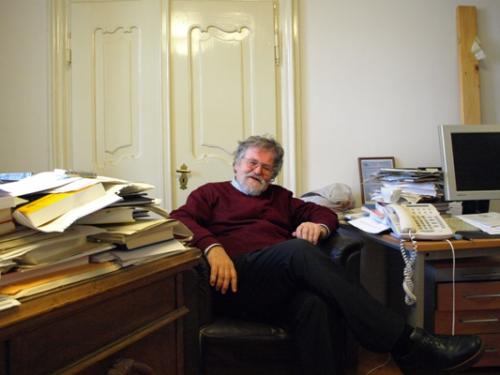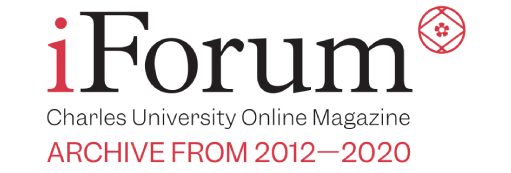I Am an Aggressive Optimist, Says Professor Jaroslav Nešetřil

P. K. • 3 January 2011
Professor Jaroslav Nešetřil, director of the Institute for Theoretical Computer Science of the Charles University Faculty of Mathematics and Physics, is a world-renowned expert on combinatorics and one of the most popular teachers at the faculty. For over 30 years, he has been teaching the Combinatorics Seminar, which is said to be a non-stop fun fest. We asked Professor Nešetřil about both mathematics and visual art.
As a kid, did you dream of becoming a scientist?
I was born in Rakovník, where, like in many other small towns, there were many artists, but not so many mathematicians – those live in Prague and other major cities. In fact, at first I had wanted to be an artist, but later I decided to study at Charles University and its Faculty of Mathematics and Physics. I’d always loved mathematics. Before I enrolled in my first year, I wanted to prepare over the summer and chose to read the mathematical analysis textbook by Professor Jarník. I think I got stuck right at the beginning. A mathematical text is not written like a narrative and the information is delivered in a condensed and austere way, so it’s not easy to read a page of it – you have to think it through. I couldn’t digest Jarník on my own, but after a few lectures at the university, it was all clear to me.
A huge influence was my grammar school professor František Lexa, with whom I took private painting lessons. Professor Lexa was a very distinguished gentleman, and looking back, the stories he used to tell me might have sparked my interest in science. While drawing, I was listening to his stories about his uncle František Lexa, who was the founder of the Institute of Egyptology at Charles University. It was exciting, like a fairy-tale. I didn’t know what it was like to be a scientist, but the mysterious world surely did attract me.
Can a mathematician get shortchanged?
People would think that us mathematicians can work with numbers and that we multiply or divide faster than others. But university level mathematics is totally different from the high school one. This is one of the biggest shocks our first-year students experience. You know, mathematics takes many forms; sociologists at the Faculty of Arts are taught something else that computer scientists. Students are surprised how we do math at the Faculty of Mathematics and Physics, but the foundation of higher mathematics is its logical construction, which is close to philosophy. We create a system of thought, which is very interconnected and depends on small details. But you know that from the bank – little things matter, like a plus or a minus sign next to your account balance. This attention to detail will also help us counting our change.
Is mathematics really the symbol of purity, in the sense that you cannot cheat in it?
Anybody can cheat, be they carpenters or lawyers, and mathematicians cheat and argue too. A company of mathematicians is like any other. Mathematics might tend to involve less cheating, because cheating in mathematics is more difficult. Mathematics is on one hand very complex, but on the other hand it is a simple science, meaning that the criterion of truthfulness is very simple. Most questions you ask in real life can be answered by both yes and no, or something in between. In mathematics, the answer is pretty much clear-cut. The basic criterion that work of mathematicians is judged by is the truthfulness of the statements that the mathematician has come up with, and that doesn’t lend itself to cheating. What’s important in mathematics is what a scholar has created and not whether he’s good or evil. Beautiful mathematics has been produced by people who were ethically bad, but that holds in many other fields as well.
Mathematician’s work can also be evaluated by aesthetic measures, such as elegance and beauty, because mathematics is very close to music and aesthetics. The things that are famous in mathematics are usually very elegant. Mathematics is not a field that creates overly complicated, hard-to-grasp things. Mathematicians like it when things are presented in a simple way, its aesthetics is not so much in the formal complexity, but in the elegance of interconnectedness.
These days, many people are concerned about their future due to government cuts. How do you manage to keep your doctoral students, who are sought after both in the commercial sector and abroad?
We are trying to provide good conditions for our doctoral students, so that they stay here – otherwise other institutions try to have them for themselves. Of course, if our centre was shut down, many of them would lose jobs. We need money to pay them, but salary is not the only motivation. Our students know that they have more freedom here and that we will support their presentations abroad, if they can make themselves recognized in the international arena. Working in the centre is an elevator to fame. In a way, it’s a very elite group. As a mathematician, you can get to the top very fast. If you look at professors at Charles University, mathematicians will be among the youngest ones. Here, you can become a professor at the age of thirty-five. Most of the time, you can’t do something like that in medicine.
You’ve been working on a computer system of aesthetic evaluation. How far into the project are you?
That’s a dream of mine. I have a small team with which I’m trying to find whether there are some regularities that we could convert into the language of algorithms and feed them into the computer. Right now, it’s at the very beginning and it’s still unclear whether it can be done. Aesthetic perception is based on a continuum, an image, a very complex object. What matters is a holistic approach – the information is in a way indivisible and we are trying to find out how to formalize it. Here, it’s not that important to find out what you do while looking at a painting, but at which moment you say you like it. Although aesthetic perception is individual, we are looking for general regularities according to which we process the image aesthetically just like the the gallery’s cleaning lady.
Lately, people have been discussing the falling level of competence in mathematics among Czech high school students. The national graduation exam project that attempted to compare competence nationwide has also been criticised. Are students really getting worse?
I am an aggressive optimist and I hate this kind of pessimistic talk. How many adults would pass driver’s licence test without preparation? If 50 per cent students pass a graduation exam, not having prepared, then in case they are prepared, all of them will pass – that’s elementary logic. Maybe the mathematics test was too easy. Do you know why we need mathematics? Mathematics is like salt. We have a beautiful fairy-tale about it. Do you eat salt? You don’t. People will tell you they don’t use salt, but if there wasn’t salt, we would end up like in that fairy-tale. Salt is not a spice, it’s the essence. If kids don’t learn math, they will wander the world full of flashing digits without understanding them. They won’t have a chance understanding the laws of the world based on mathematics. Mathematics is the essence. As parents and a country that is concerned with our future, we must decide what we want.
In 2010, Professor Jaroslav Nešetřil received the Medal of Merit, 3rd Degree for for contributions to the country in the field of science. He was also awarded the Neuron Award for his lifelong contribution to research in the field of mathematics. He has given lectures and conducted research at many of the world’s top universities and academic institutions. He has written over 350 scientific articles, he is the founder and director of the Centre of Discrete Mathematics, Theoretical Computer Science and Its Applications. He is also the director of the Institute for Theoretical Computer Science and the DIMATIA Centre. In the field of visual art, he has been collaborating with one of the most famous Czech contemporary painters, Jiří Načeradský.
P.K.
Translation: Jaroslav Švelch
